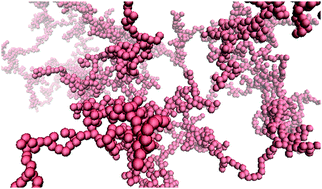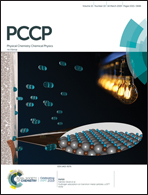Diffusion- and reaction-limited cluster aggregation revisited†
Abstract
We simulated irreversible aggregation of non-interacting particles and of particles interacting via repulsive and attractive potentials explicitly implementing the rotational diffusion of aggregating clusters. Our study confirms that the attraction between particles influences neither the aggregation mechanism nor the structure of the aggregates, which are identical to those of non-interacting particles. In contrast, repulsive particles form more compact aggregates and their fractal dimension and aggregation times increase with the decrease of the temperature. A comparison of the fractal dimensions obtained for non-rotating clusters of non-interacting particles and for rotating clusters of repulsive particles provides an explanation for the conformity of the respective values obtained earlier in the well established model of diffusion-limited cluster aggregation neglecting rotational diffusion and in experiments on colloidal particles.



 Please wait while we load your content...
Please wait while we load your content...